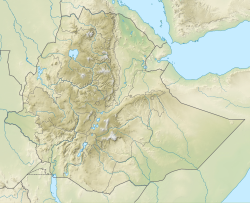
Back Hadar (Etiòpia) Catalan Hadar (Etiopie) Czech Hadar German Hadar (Etiopía) Spanish Hadar (Éthiopie) French Hadar (Etiopija) Croatian Hadar, Etiopia ID Hadar (Etiopia) Italian Hadar (Etiopia) Polish Hadar (Etiópia) Portuguese
| Location | Mille district, Afar Region, |
|---|---|
| Region | Eastern Africa |
| Coordinates | 11°10′01″N 40°37′59″E / 11.167°N 40.633°E |
| Type | Archaeological Paleontology |
| History | |
| Periods | Middle - Late Pliocene |
| Site notes | |
| Excavation dates | 1970, 1972, 1973, 1974, 2000 |
| Archaeologists | Donald Johanson Maurice Taieb Denis Geraads Zeresenay Alemseged |
| Condition | Excavated |
| Ownership | Ethiopian Government |
Hadar or Hadar Formation (also spelled Qad daqar, Qadaqar; Afar "white [qidi] stream [daqar]")[1] is a paleontological fossil site located in Mille district, Administrative Zone 1 of the Afar Region, Ethiopia, 15 km upstream (west) of the A1 road's bridge across the Awash River (Adayitu kebele).[2]
It is situated on the southern edge of the Afar Triangle (part of East Africa's Great Rift Valley), along the left banks of the Awash River, between two minor tributaries, the eponymous Kada Hadar and the Kada Gona.[2] In 1972, Taieb organized a small exploratory reconnaissance of the Afar region to investigate more paleontological finds there. After six weeks of exploration, the party focused on the Hadar site.[3]
The site has yielded some of the most well-known hominin fossils, including "Lucy". These hominin fossils range in age from approximately 3.42 to 2.90 million years ago. These finds give us a greater understanding of hominin evolution during this period.
It is postulated that the specimens in the region were deposited by way of a large river system with associated crevasse channels/splays, deltas, and distributary channels, as well as periodic transgressions of paleolake Hadar located east of the research area (Aronson and Taieb, 1981, Tiercelin, 1986, Campisano and Feibel, in press) possibly related to geological activity or climatic cycles in at least the Kada Hadar Member (Yemane et al., 1996, Yemane, 1997, Campisano and Feibel, in press)."
According to Jon Kalb, early maps show caravan routes passing within 10 to 15 km of Hadar but not through it. The British explorer L.M. Nesbitt passed 15 km west of Hadar in 1928.[1]
- ^ a b Jon Kalb Adventures in the Bone Trade (New York: Copernicus Books, 2001), p. 83
- ^ a b DiMaggio, Erin N.; Arrowsmith, J Ramón; Campisano, Christopher J.; Johnson, Roy; Deino, Alan L.; Warren, Mark; Fisseha, Shimeles; Cohen, Andrew S. (December 2015). "Tephrostratigraphy and depositional environment of young (<2.94 Ma) Hadar Formation deposits at Ledi-Geraru, Afar, Ethiopia". Journal of African Earth Sciences. 112: 234–250. Bibcode:2015JAfES.112..234D. doi:10.1016/j.jafrearsci.2015.09.018.
- ^ Johanson, Donald (March 2017). "The paleoanthropology of Hadar, Ethiopia". Comptes Rendus Palevol. 16 (2): 140–154. Bibcode:2017CRPal..16..140J. doi:10.1016/j.crpv.2016.10.005.
